Business Information Modeling Literature Review Analysis
VerifiedAdded on 2021/06/14
|11
|3095
|287
Literature Review
AI Summary
This literature review analyzes the application of Business Information Modeling (BIM) in the construction industry, examining relevant theories like Schumpeter's Theory of Economic Development, Darwin's Theory of Organic Evolution, Business Process Re-engineering, and the Theory of Disruptive Innovation. It explores empirical studies on BIM adoption, including the use of automation and additive manufacturing, comparing BIM to 3D CAD, and discussing barriers such as data interoperability, cost, and lack of knowledge. The review also identifies factors that facilitate BIM adoption, such as supportive tools, new processes, and redesigned roles. The impact of adopting BIM, including potential dissatisfaction and increased delivery time, is also discussed. The review highlights the ongoing evolution of BIM and its transformative potential within the construction sector. This document is contributed by a student to be published on the website Desklib.
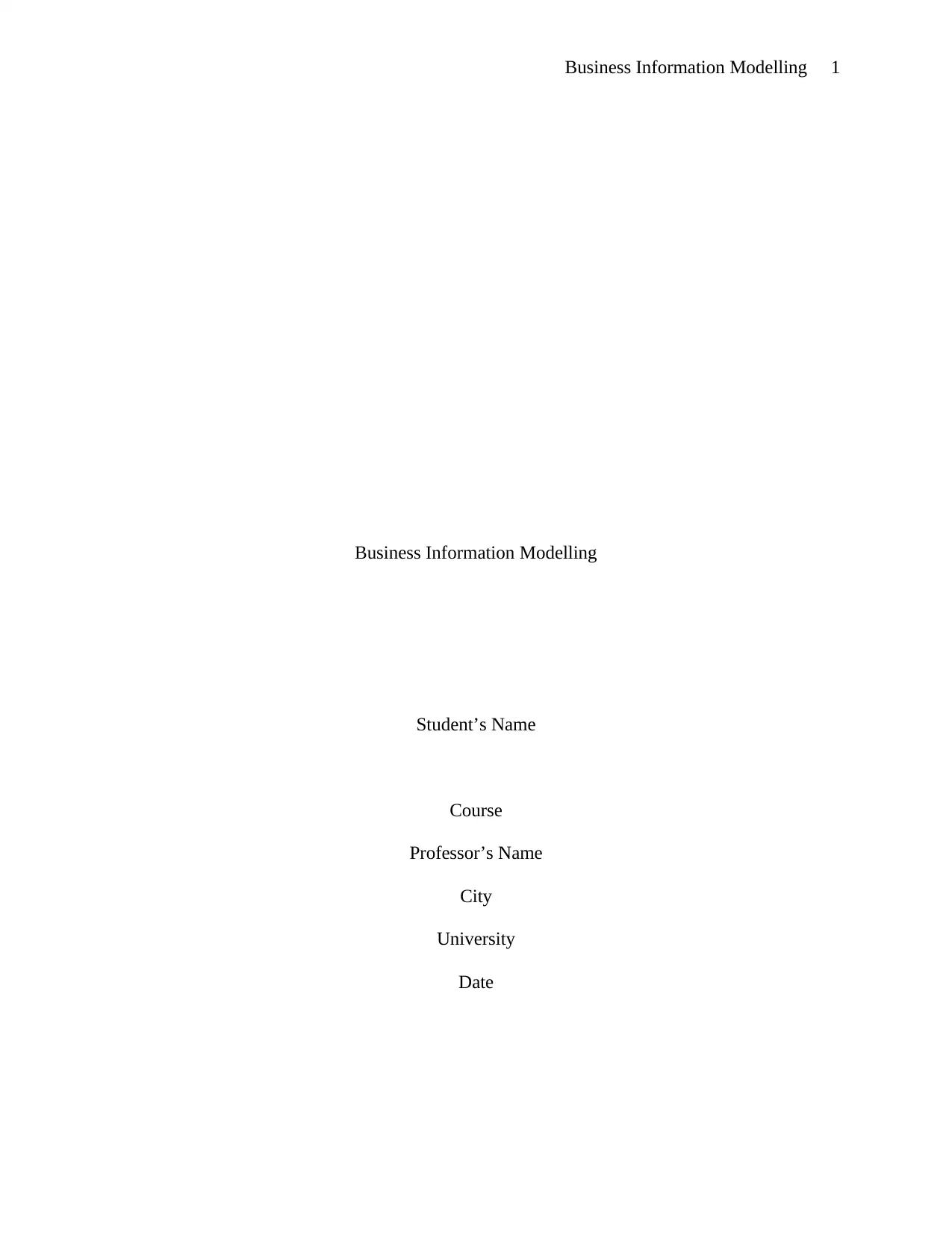
Business Information Modelling 1
Business Information Modelling
Student’s Name
Course
Professor’s Name
City
University
Date
Business Information Modelling
Student’s Name
Course
Professor’s Name
City
University
Date
Paraphrase This Document
Need a fresh take? Get an instant paraphrase of this document with our AI Paraphraser
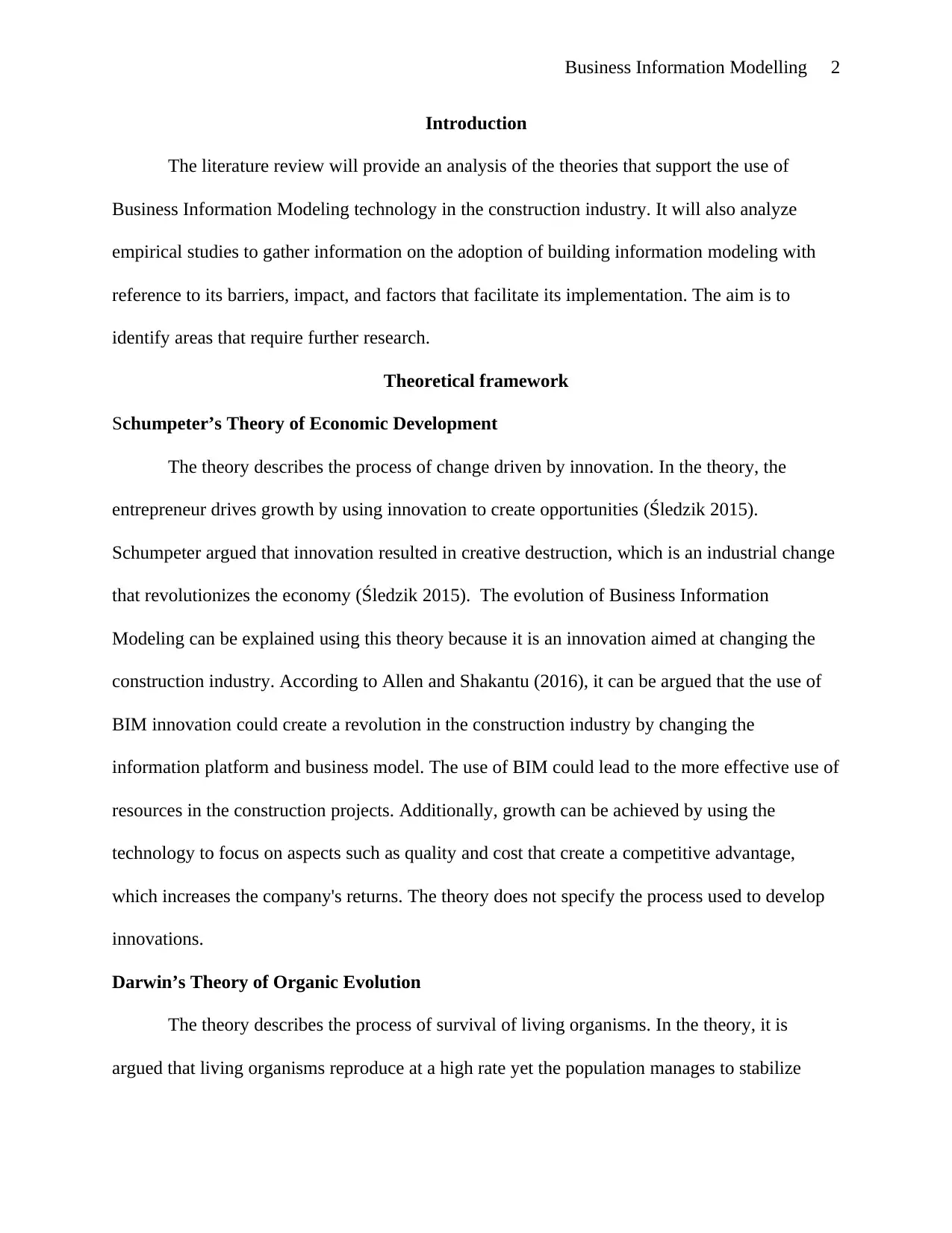
Business Information Modelling 2
Introduction
The literature review will provide an analysis of the theories that support the use of
Business Information Modeling technology in the construction industry. It will also analyze
empirical studies to gather information on the adoption of building information modeling with
reference to its barriers, impact, and factors that facilitate its implementation. The aim is to
identify areas that require further research.
Theoretical framework
Schumpeter’s Theory of Economic Development
The theory describes the process of change driven by innovation. In the theory, the
entrepreneur drives growth by using innovation to create opportunities (Śledzik 2015).
Schumpeter argued that innovation resulted in creative destruction, which is an industrial change
that revolutionizes the economy (Śledzik 2015). The evolution of Business Information
Modeling can be explained using this theory because it is an innovation aimed at changing the
construction industry. According to Allen and Shakantu (2016), it can be argued that the use of
BIM innovation could create a revolution in the construction industry by changing the
information platform and business model. The use of BIM could lead to the more effective use of
resources in the construction projects. Additionally, growth can be achieved by using the
technology to focus on aspects such as quality and cost that create a competitive advantage,
which increases the company's returns. The theory does not specify the process used to develop
innovations.
Darwin’s Theory of Organic Evolution
The theory describes the process of survival of living organisms. In the theory, it is
argued that living organisms reproduce at a high rate yet the population manages to stabilize
Introduction
The literature review will provide an analysis of the theories that support the use of
Business Information Modeling technology in the construction industry. It will also analyze
empirical studies to gather information on the adoption of building information modeling with
reference to its barriers, impact, and factors that facilitate its implementation. The aim is to
identify areas that require further research.
Theoretical framework
Schumpeter’s Theory of Economic Development
The theory describes the process of change driven by innovation. In the theory, the
entrepreneur drives growth by using innovation to create opportunities (Śledzik 2015).
Schumpeter argued that innovation resulted in creative destruction, which is an industrial change
that revolutionizes the economy (Śledzik 2015). The evolution of Business Information
Modeling can be explained using this theory because it is an innovation aimed at changing the
construction industry. According to Allen and Shakantu (2016), it can be argued that the use of
BIM innovation could create a revolution in the construction industry by changing the
information platform and business model. The use of BIM could lead to the more effective use of
resources in the construction projects. Additionally, growth can be achieved by using the
technology to focus on aspects such as quality and cost that create a competitive advantage,
which increases the company's returns. The theory does not specify the process used to develop
innovations.
Darwin’s Theory of Organic Evolution
The theory describes the process of survival of living organisms. In the theory, it is
argued that living organisms reproduce at a high rate yet the population manages to stabilize
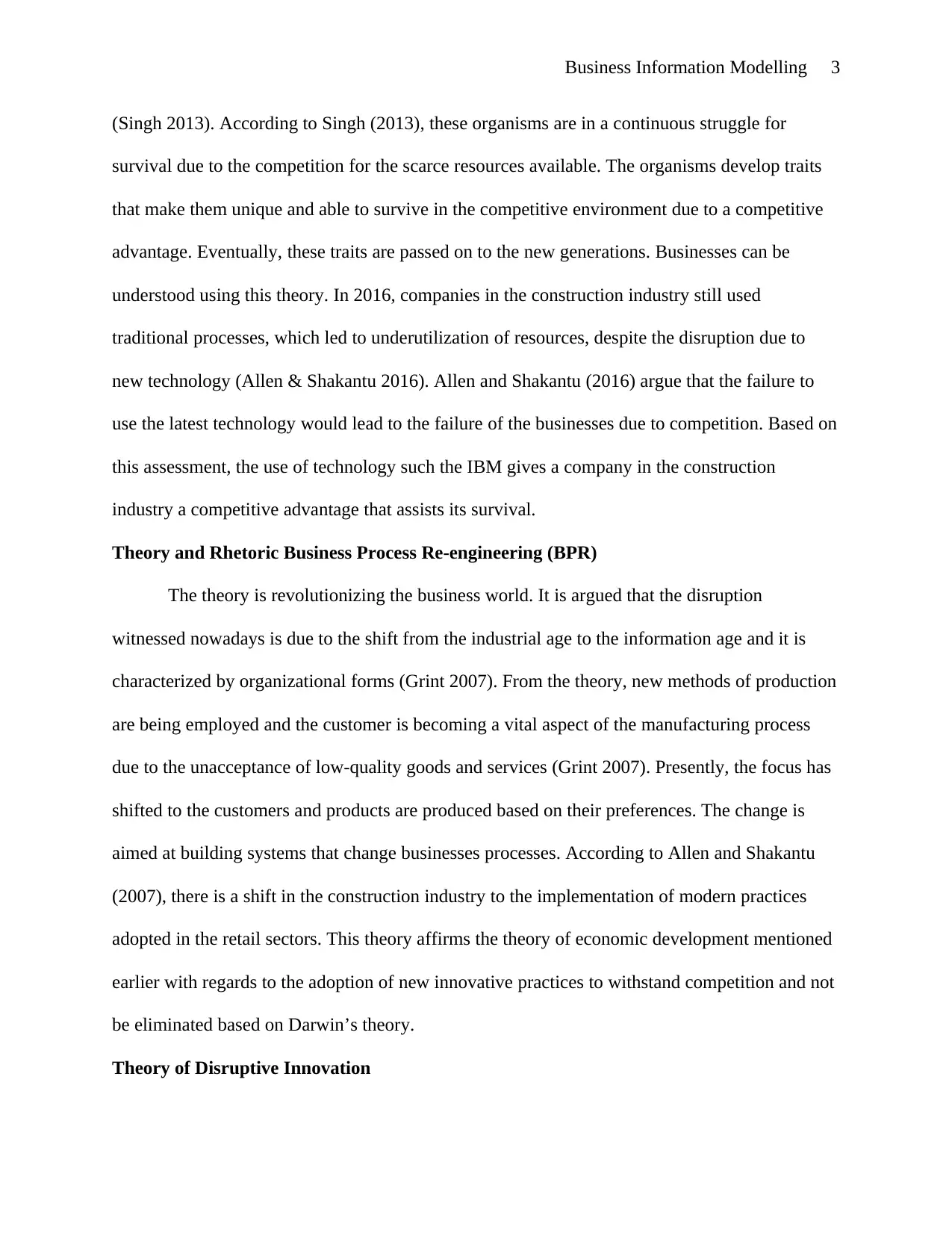
Business Information Modelling 3
(Singh 2013). According to Singh (2013), these organisms are in a continuous struggle for
survival due to the competition for the scarce resources available. The organisms develop traits
that make them unique and able to survive in the competitive environment due to a competitive
advantage. Eventually, these traits are passed on to the new generations. Businesses can be
understood using this theory. In 2016, companies in the construction industry still used
traditional processes, which led to underutilization of resources, despite the disruption due to
new technology (Allen & Shakantu 2016). Allen and Shakantu (2016) argue that the failure to
use the latest technology would lead to the failure of the businesses due to competition. Based on
this assessment, the use of technology such the IBM gives a company in the construction
industry a competitive advantage that assists its survival.
Theory and Rhetoric Business Process Re-engineering (BPR)
The theory is revolutionizing the business world. It is argued that the disruption
witnessed nowadays is due to the shift from the industrial age to the information age and it is
characterized by organizational forms (Grint 2007). From the theory, new methods of production
are being employed and the customer is becoming a vital aspect of the manufacturing process
due to the unacceptance of low-quality goods and services (Grint 2007). Presently, the focus has
shifted to the customers and products are produced based on their preferences. The change is
aimed at building systems that change businesses processes. According to Allen and Shakantu
(2007), there is a shift in the construction industry to the implementation of modern practices
adopted in the retail sectors. This theory affirms the theory of economic development mentioned
earlier with regards to the adoption of new innovative practices to withstand competition and not
be eliminated based on Darwin’s theory.
Theory of Disruptive Innovation
(Singh 2013). According to Singh (2013), these organisms are in a continuous struggle for
survival due to the competition for the scarce resources available. The organisms develop traits
that make them unique and able to survive in the competitive environment due to a competitive
advantage. Eventually, these traits are passed on to the new generations. Businesses can be
understood using this theory. In 2016, companies in the construction industry still used
traditional processes, which led to underutilization of resources, despite the disruption due to
new technology (Allen & Shakantu 2016). Allen and Shakantu (2016) argue that the failure to
use the latest technology would lead to the failure of the businesses due to competition. Based on
this assessment, the use of technology such the IBM gives a company in the construction
industry a competitive advantage that assists its survival.
Theory and Rhetoric Business Process Re-engineering (BPR)
The theory is revolutionizing the business world. It is argued that the disruption
witnessed nowadays is due to the shift from the industrial age to the information age and it is
characterized by organizational forms (Grint 2007). From the theory, new methods of production
are being employed and the customer is becoming a vital aspect of the manufacturing process
due to the unacceptance of low-quality goods and services (Grint 2007). Presently, the focus has
shifted to the customers and products are produced based on their preferences. The change is
aimed at building systems that change businesses processes. According to Allen and Shakantu
(2007), there is a shift in the construction industry to the implementation of modern practices
adopted in the retail sectors. This theory affirms the theory of economic development mentioned
earlier with regards to the adoption of new innovative practices to withstand competition and not
be eliminated based on Darwin’s theory.
Theory of Disruptive Innovation
⊘ This is a preview!⊘
Do you want full access?
Subscribe today to unlock all pages.

Trusted by 1+ million students worldwide
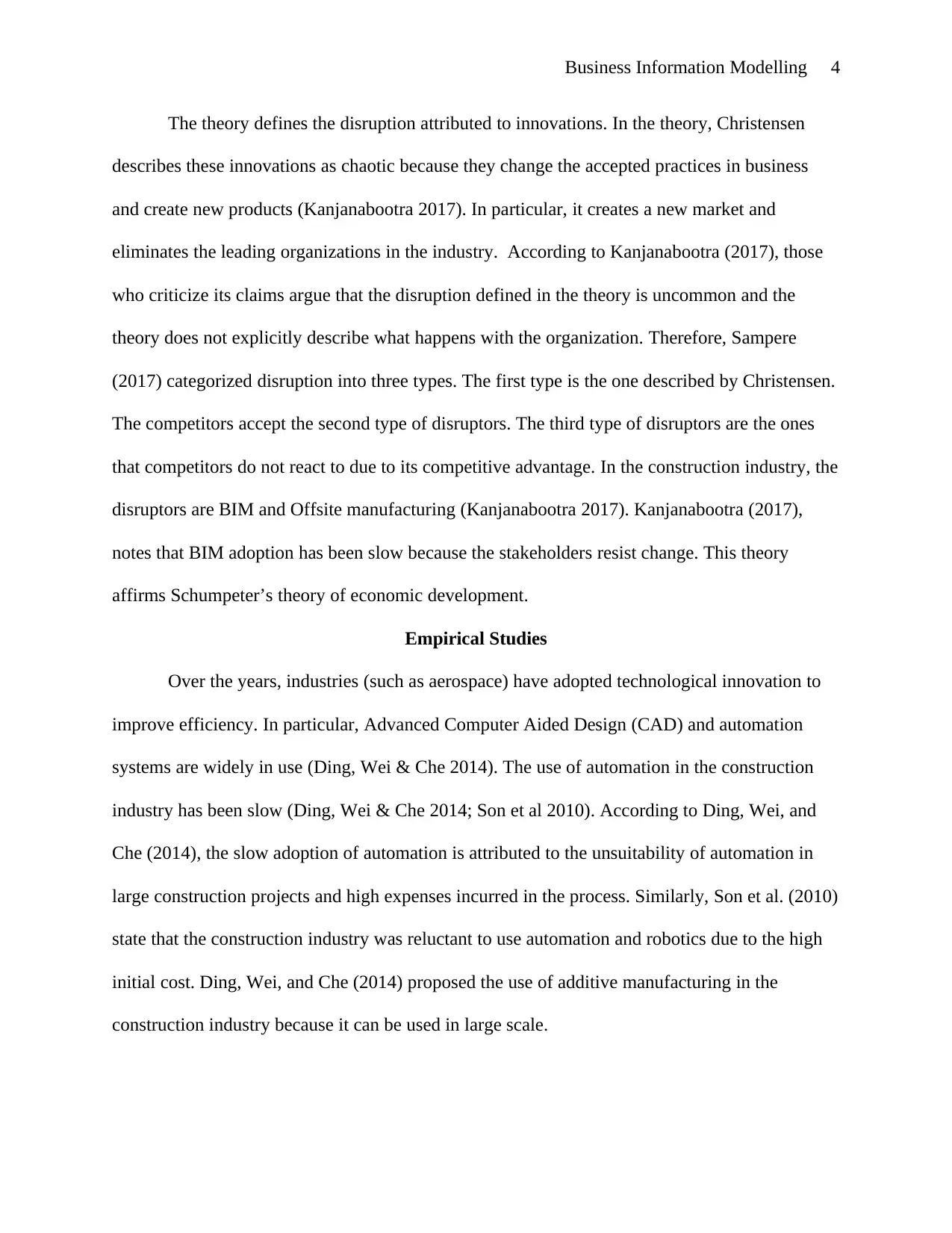
Business Information Modelling 4
The theory defines the disruption attributed to innovations. In the theory, Christensen
describes these innovations as chaotic because they change the accepted practices in business
and create new products (Kanjanabootra 2017). In particular, it creates a new market and
eliminates the leading organizations in the industry. According to Kanjanabootra (2017), those
who criticize its claims argue that the disruption defined in the theory is uncommon and the
theory does not explicitly describe what happens with the organization. Therefore, Sampere
(2017) categorized disruption into three types. The first type is the one described by Christensen.
The competitors accept the second type of disruptors. The third type of disruptors are the ones
that competitors do not react to due to its competitive advantage. In the construction industry, the
disruptors are BIM and Offsite manufacturing (Kanjanabootra 2017). Kanjanabootra (2017),
notes that BIM adoption has been slow because the stakeholders resist change. This theory
affirms Schumpeter’s theory of economic development.
Empirical Studies
Over the years, industries (such as aerospace) have adopted technological innovation to
improve efficiency. In particular, Advanced Computer Aided Design (CAD) and automation
systems are widely in use (Ding, Wei & Che 2014). The use of automation in the construction
industry has been slow (Ding, Wei & Che 2014; Son et al 2010). According to Ding, Wei, and
Che (2014), the slow adoption of automation is attributed to the unsuitability of automation in
large construction projects and high expenses incurred in the process. Similarly, Son et al. (2010)
state that the construction industry was reluctant to use automation and robotics due to the high
initial cost. Ding, Wei, and Che (2014) proposed the use of additive manufacturing in the
construction industry because it can be used in large scale.
The theory defines the disruption attributed to innovations. In the theory, Christensen
describes these innovations as chaotic because they change the accepted practices in business
and create new products (Kanjanabootra 2017). In particular, it creates a new market and
eliminates the leading organizations in the industry. According to Kanjanabootra (2017), those
who criticize its claims argue that the disruption defined in the theory is uncommon and the
theory does not explicitly describe what happens with the organization. Therefore, Sampere
(2017) categorized disruption into three types. The first type is the one described by Christensen.
The competitors accept the second type of disruptors. The third type of disruptors are the ones
that competitors do not react to due to its competitive advantage. In the construction industry, the
disruptors are BIM and Offsite manufacturing (Kanjanabootra 2017). Kanjanabootra (2017),
notes that BIM adoption has been slow because the stakeholders resist change. This theory
affirms Schumpeter’s theory of economic development.
Empirical Studies
Over the years, industries (such as aerospace) have adopted technological innovation to
improve efficiency. In particular, Advanced Computer Aided Design (CAD) and automation
systems are widely in use (Ding, Wei & Che 2014). The use of automation in the construction
industry has been slow (Ding, Wei & Che 2014; Son et al 2010). According to Ding, Wei, and
Che (2014), the slow adoption of automation is attributed to the unsuitability of automation in
large construction projects and high expenses incurred in the process. Similarly, Son et al. (2010)
state that the construction industry was reluctant to use automation and robotics due to the high
initial cost. Ding, Wei, and Che (2014) proposed the use of additive manufacturing in the
construction industry because it can be used in large scale.
Paraphrase This Document
Need a fresh take? Get an instant paraphrase of this document with our AI Paraphraser
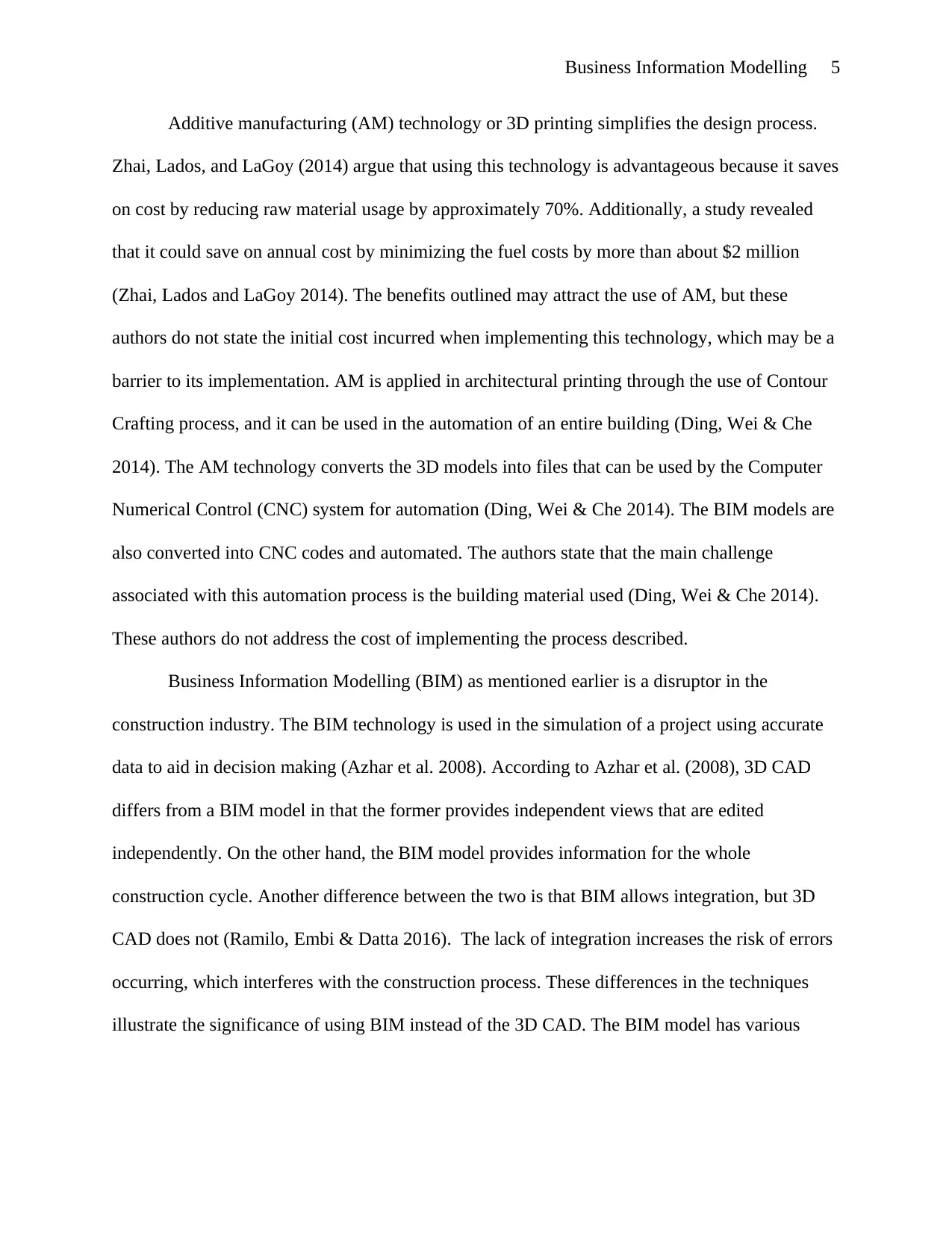
Business Information Modelling 5
Additive manufacturing (AM) technology or 3D printing simplifies the design process.
Zhai, Lados, and LaGoy (2014) argue that using this technology is advantageous because it saves
on cost by reducing raw material usage by approximately 70%. Additionally, a study revealed
that it could save on annual cost by minimizing the fuel costs by more than about $2 million
(Zhai, Lados and LaGoy 2014). The benefits outlined may attract the use of AM, but these
authors do not state the initial cost incurred when implementing this technology, which may be a
barrier to its implementation. AM is applied in architectural printing through the use of Contour
Crafting process, and it can be used in the automation of an entire building (Ding, Wei & Che
2014). The AM technology converts the 3D models into files that can be used by the Computer
Numerical Control (CNC) system for automation (Ding, Wei & Che 2014). The BIM models are
also converted into CNC codes and automated. The authors state that the main challenge
associated with this automation process is the building material used (Ding, Wei & Che 2014).
These authors do not address the cost of implementing the process described.
Business Information Modelling (BIM) as mentioned earlier is a disruptor in the
construction industry. The BIM technology is used in the simulation of a project using accurate
data to aid in decision making (Azhar et al. 2008). According to Azhar et al. (2008), 3D CAD
differs from a BIM model in that the former provides independent views that are edited
independently. On the other hand, the BIM model provides information for the whole
construction cycle. Another difference between the two is that BIM allows integration, but 3D
CAD does not (Ramilo, Embi & Datta 2016). The lack of integration increases the risk of errors
occurring, which interferes with the construction process. These differences in the techniques
illustrate the significance of using BIM instead of the 3D CAD. The BIM model has various
Additive manufacturing (AM) technology or 3D printing simplifies the design process.
Zhai, Lados, and LaGoy (2014) argue that using this technology is advantageous because it saves
on cost by reducing raw material usage by approximately 70%. Additionally, a study revealed
that it could save on annual cost by minimizing the fuel costs by more than about $2 million
(Zhai, Lados and LaGoy 2014). The benefits outlined may attract the use of AM, but these
authors do not state the initial cost incurred when implementing this technology, which may be a
barrier to its implementation. AM is applied in architectural printing through the use of Contour
Crafting process, and it can be used in the automation of an entire building (Ding, Wei & Che
2014). The AM technology converts the 3D models into files that can be used by the Computer
Numerical Control (CNC) system for automation (Ding, Wei & Che 2014). The BIM models are
also converted into CNC codes and automated. The authors state that the main challenge
associated with this automation process is the building material used (Ding, Wei & Che 2014).
These authors do not address the cost of implementing the process described.
Business Information Modelling (BIM) as mentioned earlier is a disruptor in the
construction industry. The BIM technology is used in the simulation of a project using accurate
data to aid in decision making (Azhar et al. 2008). According to Azhar et al. (2008), 3D CAD
differs from a BIM model in that the former provides independent views that are edited
independently. On the other hand, the BIM model provides information for the whole
construction cycle. Another difference between the two is that BIM allows integration, but 3D
CAD does not (Ramilo, Embi & Datta 2016). The lack of integration increases the risk of errors
occurring, which interferes with the construction process. These differences in the techniques
illustrate the significance of using BIM instead of the 3D CAD. The BIM model has various
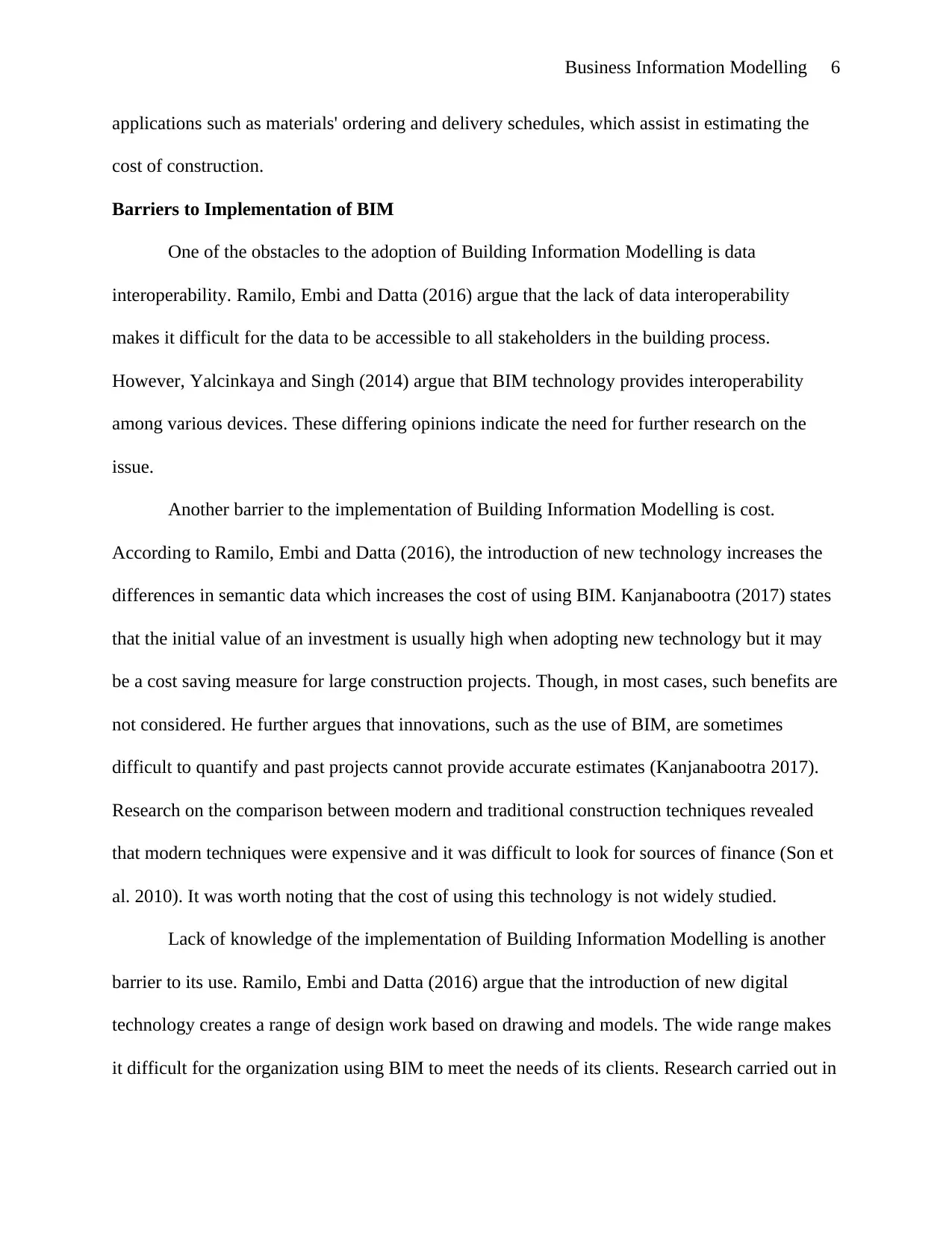
Business Information Modelling 6
applications such as materials' ordering and delivery schedules, which assist in estimating the
cost of construction.
Barriers to Implementation of BIM
One of the obstacles to the adoption of Building Information Modelling is data
interoperability. Ramilo, Embi and Datta (2016) argue that the lack of data interoperability
makes it difficult for the data to be accessible to all stakeholders in the building process.
However, Yalcinkaya and Singh (2014) argue that BIM technology provides interoperability
among various devices. These differing opinions indicate the need for further research on the
issue.
Another barrier to the implementation of Building Information Modelling is cost.
According to Ramilo, Embi and Datta (2016), the introduction of new technology increases the
differences in semantic data which increases the cost of using BIM. Kanjanabootra (2017) states
that the initial value of an investment is usually high when adopting new technology but it may
be a cost saving measure for large construction projects. Though, in most cases, such benefits are
not considered. He further argues that innovations, such as the use of BIM, are sometimes
difficult to quantify and past projects cannot provide accurate estimates (Kanjanabootra 2017).
Research on the comparison between modern and traditional construction techniques revealed
that modern techniques were expensive and it was difficult to look for sources of finance (Son et
al. 2010). It was worth noting that the cost of using this technology is not widely studied.
Lack of knowledge of the implementation of Building Information Modelling is another
barrier to its use. Ramilo, Embi and Datta (2016) argue that the introduction of new digital
technology creates a range of design work based on drawing and models. The wide range makes
it difficult for the organization using BIM to meet the needs of its clients. Research carried out in
applications such as materials' ordering and delivery schedules, which assist in estimating the
cost of construction.
Barriers to Implementation of BIM
One of the obstacles to the adoption of Building Information Modelling is data
interoperability. Ramilo, Embi and Datta (2016) argue that the lack of data interoperability
makes it difficult for the data to be accessible to all stakeholders in the building process.
However, Yalcinkaya and Singh (2014) argue that BIM technology provides interoperability
among various devices. These differing opinions indicate the need for further research on the
issue.
Another barrier to the implementation of Building Information Modelling is cost.
According to Ramilo, Embi and Datta (2016), the introduction of new technology increases the
differences in semantic data which increases the cost of using BIM. Kanjanabootra (2017) states
that the initial value of an investment is usually high when adopting new technology but it may
be a cost saving measure for large construction projects. Though, in most cases, such benefits are
not considered. He further argues that innovations, such as the use of BIM, are sometimes
difficult to quantify and past projects cannot provide accurate estimates (Kanjanabootra 2017).
Research on the comparison between modern and traditional construction techniques revealed
that modern techniques were expensive and it was difficult to look for sources of finance (Son et
al. 2010). It was worth noting that the cost of using this technology is not widely studied.
Lack of knowledge of the implementation of Building Information Modelling is another
barrier to its use. Ramilo, Embi and Datta (2016) argue that the introduction of new digital
technology creates a range of design work based on drawing and models. The wide range makes
it difficult for the organization using BIM to meet the needs of its clients. Research carried out in
⊘ This is a preview!⊘
Do you want full access?
Subscribe today to unlock all pages.

Trusted by 1+ million students worldwide
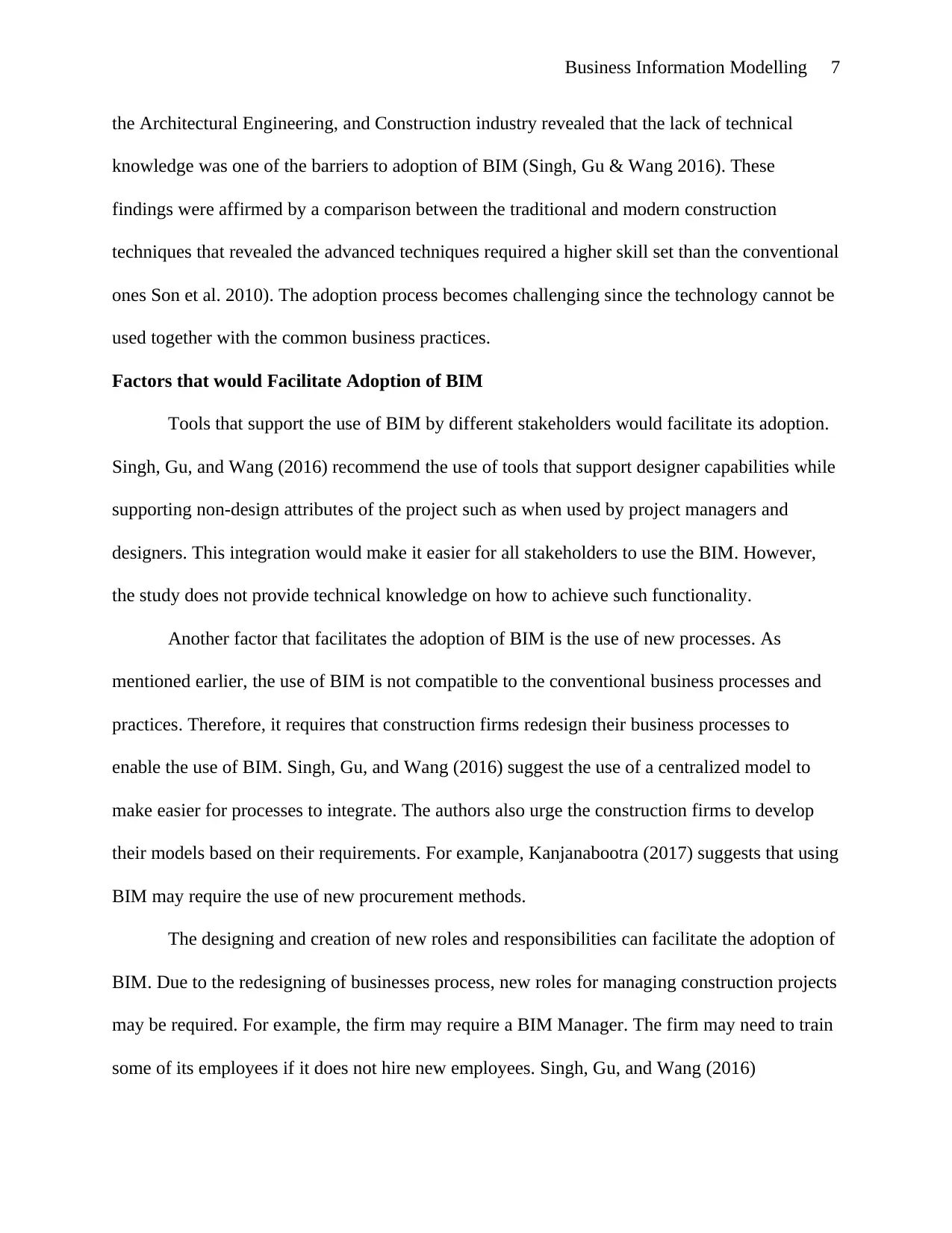
Business Information Modelling 7
the Architectural Engineering, and Construction industry revealed that the lack of technical
knowledge was one of the barriers to adoption of BIM (Singh, Gu & Wang 2016). These
findings were affirmed by a comparison between the traditional and modern construction
techniques that revealed the advanced techniques required a higher skill set than the conventional
ones Son et al. 2010). The adoption process becomes challenging since the technology cannot be
used together with the common business practices.
Factors that would Facilitate Adoption of BIM
Tools that support the use of BIM by different stakeholders would facilitate its adoption.
Singh, Gu, and Wang (2016) recommend the use of tools that support designer capabilities while
supporting non-design attributes of the project such as when used by project managers and
designers. This integration would make it easier for all stakeholders to use the BIM. However,
the study does not provide technical knowledge on how to achieve such functionality.
Another factor that facilitates the adoption of BIM is the use of new processes. As
mentioned earlier, the use of BIM is not compatible to the conventional business processes and
practices. Therefore, it requires that construction firms redesign their business processes to
enable the use of BIM. Singh, Gu, and Wang (2016) suggest the use of a centralized model to
make easier for processes to integrate. The authors also urge the construction firms to develop
their models based on their requirements. For example, Kanjanabootra (2017) suggests that using
BIM may require the use of new procurement methods.
The designing and creation of new roles and responsibilities can facilitate the adoption of
BIM. Due to the redesigning of businesses process, new roles for managing construction projects
may be required. For example, the firm may require a BIM Manager. The firm may need to train
some of its employees if it does not hire new employees. Singh, Gu, and Wang (2016)
the Architectural Engineering, and Construction industry revealed that the lack of technical
knowledge was one of the barriers to adoption of BIM (Singh, Gu & Wang 2016). These
findings were affirmed by a comparison between the traditional and modern construction
techniques that revealed the advanced techniques required a higher skill set than the conventional
ones Son et al. 2010). The adoption process becomes challenging since the technology cannot be
used together with the common business practices.
Factors that would Facilitate Adoption of BIM
Tools that support the use of BIM by different stakeholders would facilitate its adoption.
Singh, Gu, and Wang (2016) recommend the use of tools that support designer capabilities while
supporting non-design attributes of the project such as when used by project managers and
designers. This integration would make it easier for all stakeholders to use the BIM. However,
the study does not provide technical knowledge on how to achieve such functionality.
Another factor that facilitates the adoption of BIM is the use of new processes. As
mentioned earlier, the use of BIM is not compatible to the conventional business processes and
practices. Therefore, it requires that construction firms redesign their business processes to
enable the use of BIM. Singh, Gu, and Wang (2016) suggest the use of a centralized model to
make easier for processes to integrate. The authors also urge the construction firms to develop
their models based on their requirements. For example, Kanjanabootra (2017) suggests that using
BIM may require the use of new procurement methods.
The designing and creation of new roles and responsibilities can facilitate the adoption of
BIM. Due to the redesigning of businesses process, new roles for managing construction projects
may be required. For example, the firm may require a BIM Manager. The firm may need to train
some of its employees if it does not hire new employees. Singh, Gu, and Wang (2016)
Paraphrase This Document
Need a fresh take? Get an instant paraphrase of this document with our AI Paraphraser
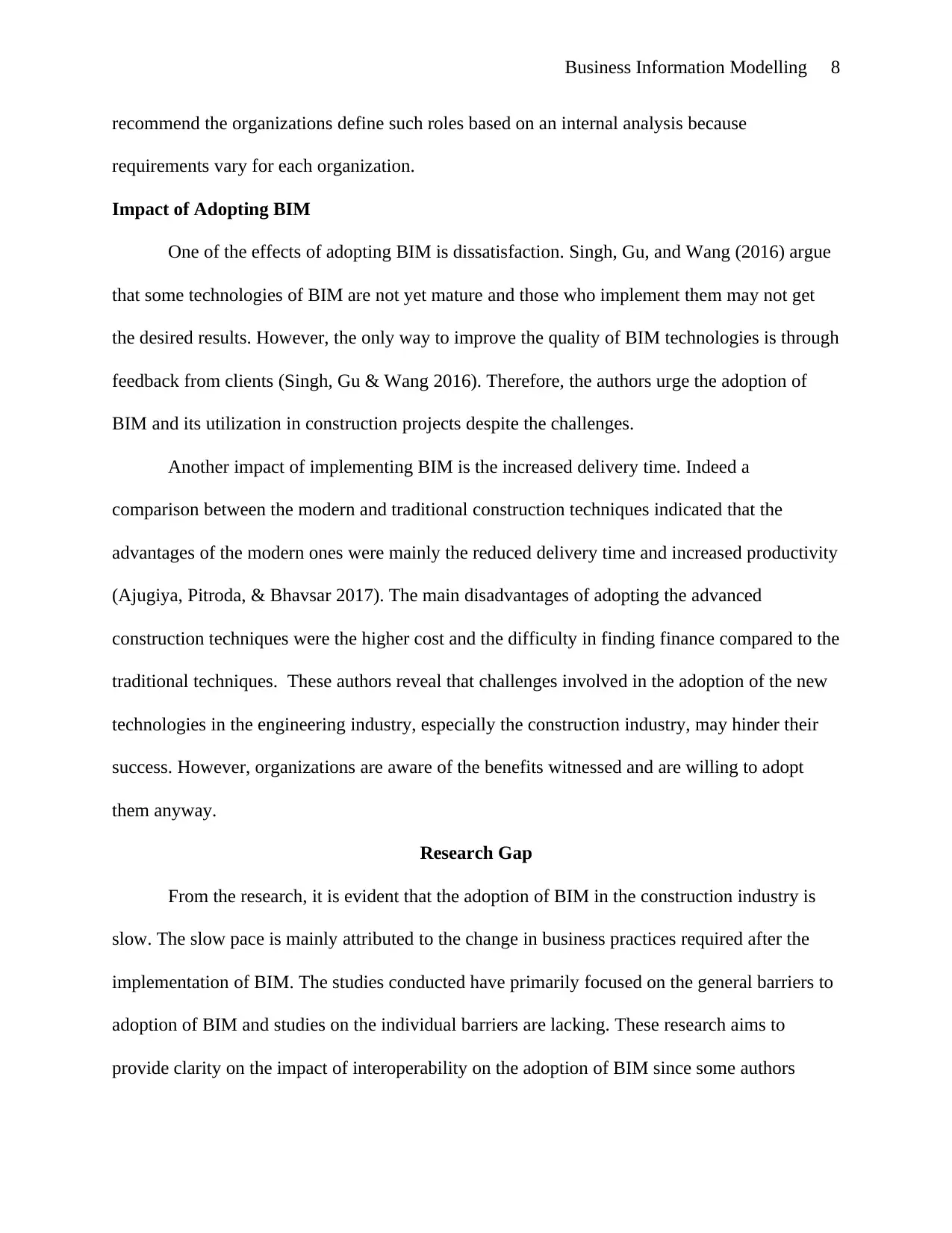
Business Information Modelling 8
recommend the organizations define such roles based on an internal analysis because
requirements vary for each organization.
Impact of Adopting BIM
One of the effects of adopting BIM is dissatisfaction. Singh, Gu, and Wang (2016) argue
that some technologies of BIM are not yet mature and those who implement them may not get
the desired results. However, the only way to improve the quality of BIM technologies is through
feedback from clients (Singh, Gu & Wang 2016). Therefore, the authors urge the adoption of
BIM and its utilization in construction projects despite the challenges.
Another impact of implementing BIM is the increased delivery time. Indeed a
comparison between the modern and traditional construction techniques indicated that the
advantages of the modern ones were mainly the reduced delivery time and increased productivity
(Ajugiya, Pitroda, & Bhavsar 2017). The main disadvantages of adopting the advanced
construction techniques were the higher cost and the difficulty in finding finance compared to the
traditional techniques. These authors reveal that challenges involved in the adoption of the new
technologies in the engineering industry, especially the construction industry, may hinder their
success. However, organizations are aware of the benefits witnessed and are willing to adopt
them anyway.
Research Gap
From the research, it is evident that the adoption of BIM in the construction industry is
slow. The slow pace is mainly attributed to the change in business practices required after the
implementation of BIM. The studies conducted have primarily focused on the general barriers to
adoption of BIM and studies on the individual barriers are lacking. These research aims to
provide clarity on the impact of interoperability on the adoption of BIM since some authors
recommend the organizations define such roles based on an internal analysis because
requirements vary for each organization.
Impact of Adopting BIM
One of the effects of adopting BIM is dissatisfaction. Singh, Gu, and Wang (2016) argue
that some technologies of BIM are not yet mature and those who implement them may not get
the desired results. However, the only way to improve the quality of BIM technologies is through
feedback from clients (Singh, Gu & Wang 2016). Therefore, the authors urge the adoption of
BIM and its utilization in construction projects despite the challenges.
Another impact of implementing BIM is the increased delivery time. Indeed a
comparison between the modern and traditional construction techniques indicated that the
advantages of the modern ones were mainly the reduced delivery time and increased productivity
(Ajugiya, Pitroda, & Bhavsar 2017). The main disadvantages of adopting the advanced
construction techniques were the higher cost and the difficulty in finding finance compared to the
traditional techniques. These authors reveal that challenges involved in the adoption of the new
technologies in the engineering industry, especially the construction industry, may hinder their
success. However, organizations are aware of the benefits witnessed and are willing to adopt
them anyway.
Research Gap
From the research, it is evident that the adoption of BIM in the construction industry is
slow. The slow pace is mainly attributed to the change in business practices required after the
implementation of BIM. The studies conducted have primarily focused on the general barriers to
adoption of BIM and studies on the individual barriers are lacking. These research aims to
provide clarity on the impact of interoperability on the adoption of BIM since some authors
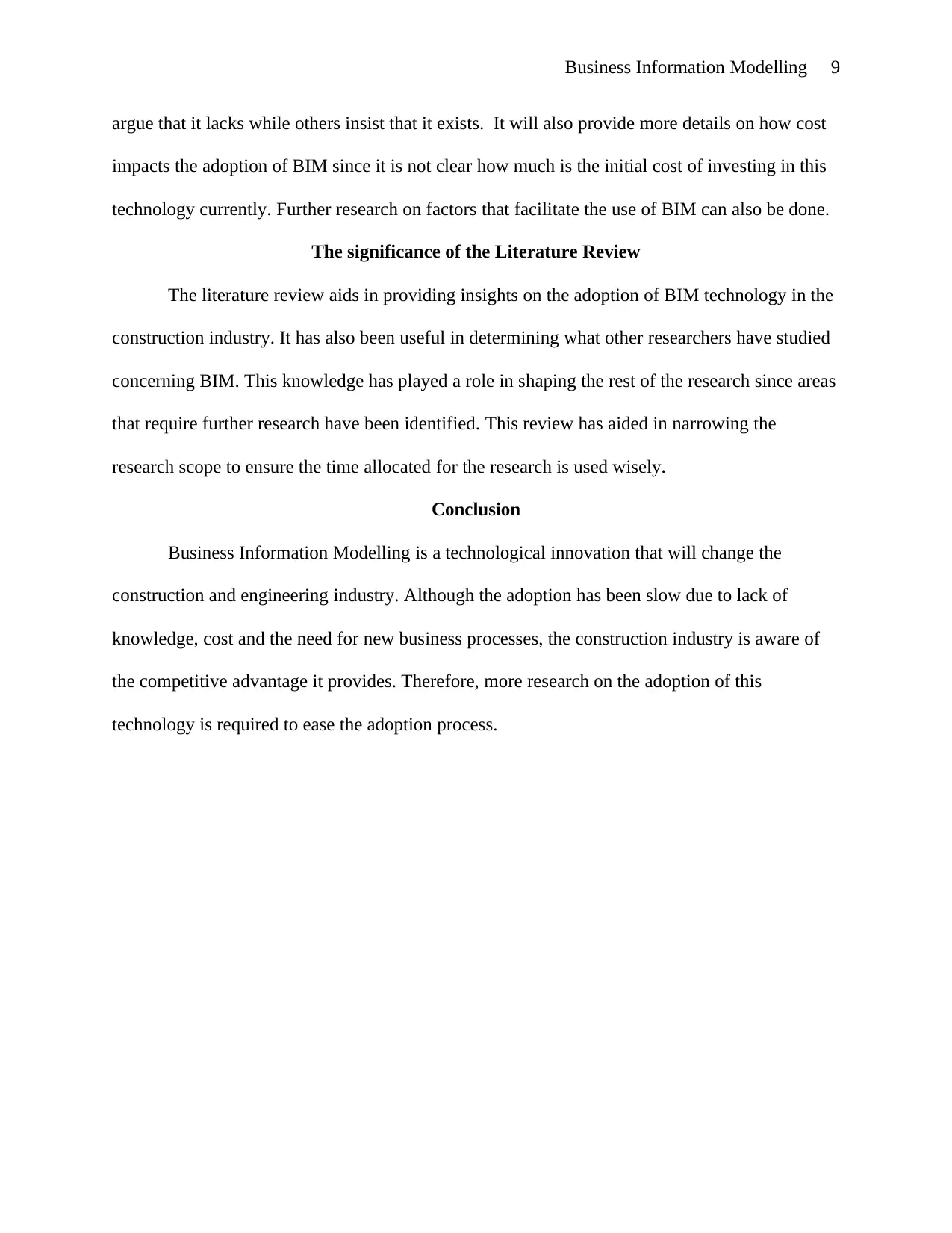
Business Information Modelling 9
argue that it lacks while others insist that it exists. It will also provide more details on how cost
impacts the adoption of BIM since it is not clear how much is the initial cost of investing in this
technology currently. Further research on factors that facilitate the use of BIM can also be done.
The significance of the Literature Review
The literature review aids in providing insights on the adoption of BIM technology in the
construction industry. It has also been useful in determining what other researchers have studied
concerning BIM. This knowledge has played a role in shaping the rest of the research since areas
that require further research have been identified. This review has aided in narrowing the
research scope to ensure the time allocated for the research is used wisely.
Conclusion
Business Information Modelling is a technological innovation that will change the
construction and engineering industry. Although the adoption has been slow due to lack of
knowledge, cost and the need for new business processes, the construction industry is aware of
the competitive advantage it provides. Therefore, more research on the adoption of this
technology is required to ease the adoption process.
argue that it lacks while others insist that it exists. It will also provide more details on how cost
impacts the adoption of BIM since it is not clear how much is the initial cost of investing in this
technology currently. Further research on factors that facilitate the use of BIM can also be done.
The significance of the Literature Review
The literature review aids in providing insights on the adoption of BIM technology in the
construction industry. It has also been useful in determining what other researchers have studied
concerning BIM. This knowledge has played a role in shaping the rest of the research since areas
that require further research have been identified. This review has aided in narrowing the
research scope to ensure the time allocated for the research is used wisely.
Conclusion
Business Information Modelling is a technological innovation that will change the
construction and engineering industry. Although the adoption has been slow due to lack of
knowledge, cost and the need for new business processes, the construction industry is aware of
the competitive advantage it provides. Therefore, more research on the adoption of this
technology is required to ease the adoption process.
⊘ This is a preview!⊘
Do you want full access?
Subscribe today to unlock all pages.

Trusted by 1+ million students worldwide
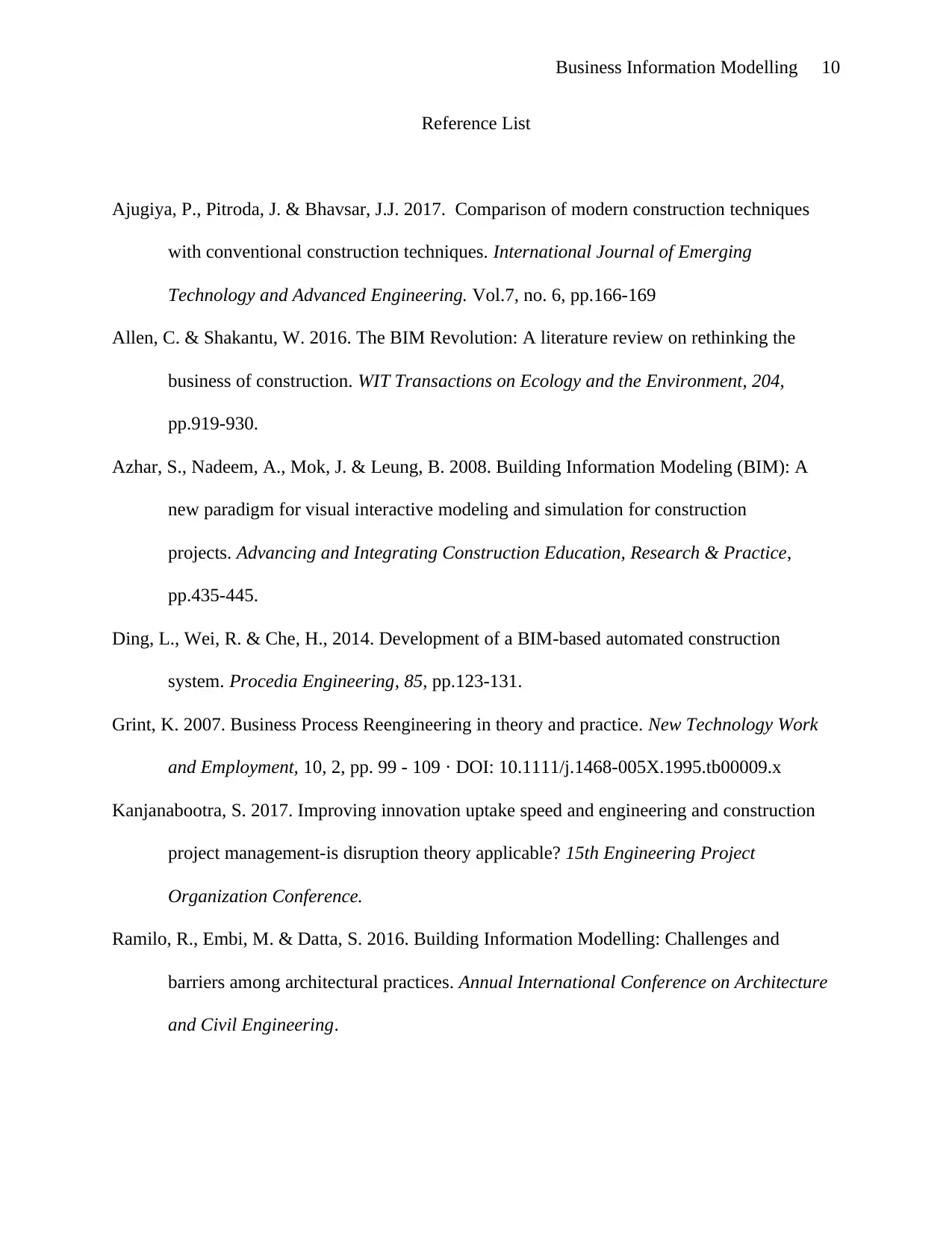
Business Information Modelling 10
Reference List
Ajugiya, P., Pitroda, J. & Bhavsar, J.J. 2017. Comparison of modern construction techniques
with conventional construction techniques. International Journal of Emerging
Technology and Advanced Engineering. Vol.7, no. 6, pp.166-169
Allen, C. & Shakantu, W. 2016. The BIM Revolution: A literature review on rethinking the
business of construction. WIT Transactions on Ecology and the Environment, 204,
pp.919-930.
Azhar, S., Nadeem, A., Mok, J. & Leung, B. 2008. Building Information Modeling (BIM): A
new paradigm for visual interactive modeling and simulation for construction
projects. Advancing and Integrating Construction Education, Research & Practice,
pp.435-445.
Ding, L., Wei, R. & Che, H., 2014. Development of a BIM-based automated construction
system. Procedia Engineering, 85, pp.123-131.
Grint, K. 2007. Business Process Reengineering in theory and practice. New Technology Work
and Employment, 10, 2, pp. 99 - 109 · DOI: 10.1111/j.1468-005X.1995.tb00009.x
Kanjanabootra, S. 2017. Improving innovation uptake speed and engineering and construction
project management-is disruption theory applicable? 15th Engineering Project
Organization Conference.
Ramilo, R., Embi, M. & Datta, S. 2016. Building Information Modelling: Challenges and
barriers among architectural practices. Annual International Conference on Architecture
and Civil Engineering.
Reference List
Ajugiya, P., Pitroda, J. & Bhavsar, J.J. 2017. Comparison of modern construction techniques
with conventional construction techniques. International Journal of Emerging
Technology and Advanced Engineering. Vol.7, no. 6, pp.166-169
Allen, C. & Shakantu, W. 2016. The BIM Revolution: A literature review on rethinking the
business of construction. WIT Transactions on Ecology and the Environment, 204,
pp.919-930.
Azhar, S., Nadeem, A., Mok, J. & Leung, B. 2008. Building Information Modeling (BIM): A
new paradigm for visual interactive modeling and simulation for construction
projects. Advancing and Integrating Construction Education, Research & Practice,
pp.435-445.
Ding, L., Wei, R. & Che, H., 2014. Development of a BIM-based automated construction
system. Procedia Engineering, 85, pp.123-131.
Grint, K. 2007. Business Process Reengineering in theory and practice. New Technology Work
and Employment, 10, 2, pp. 99 - 109 · DOI: 10.1111/j.1468-005X.1995.tb00009.x
Kanjanabootra, S. 2017. Improving innovation uptake speed and engineering and construction
project management-is disruption theory applicable? 15th Engineering Project
Organization Conference.
Ramilo, R., Embi, M. & Datta, S. 2016. Building Information Modelling: Challenges and
barriers among architectural practices. Annual International Conference on Architecture
and Civil Engineering.
Paraphrase This Document
Need a fresh take? Get an instant paraphrase of this document with our AI Paraphraser
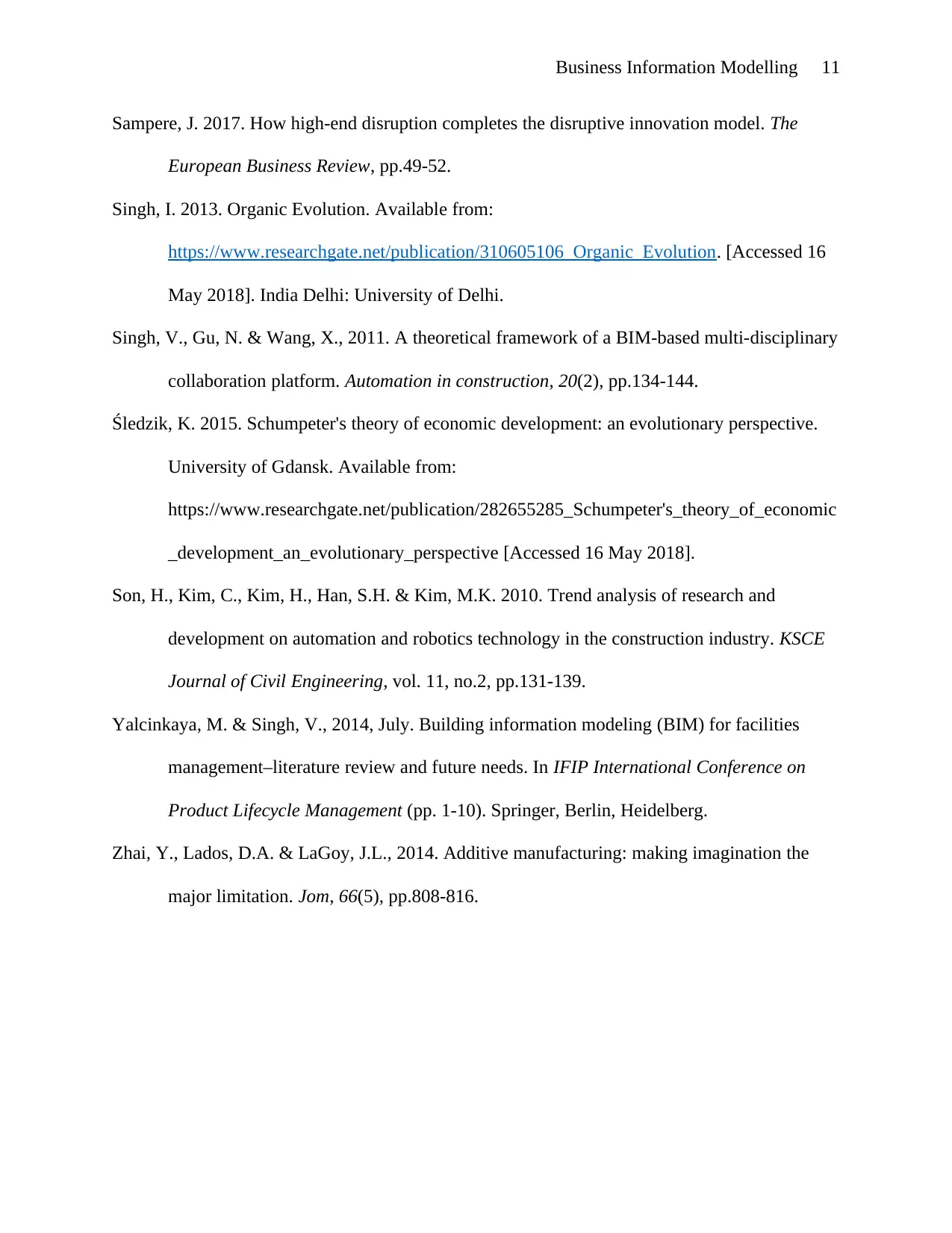
Business Information Modelling 11
Sampere, J. 2017. How high-end disruption completes the disruptive innovation model. The
European Business Review, pp.49-52.
Singh, I. 2013. Organic Evolution. Available from:
https://www.researchgate.net/publication/310605106_Organic_Evolution. [Accessed 16
May 2018]. India Delhi: University of Delhi.
Singh, V., Gu, N. & Wang, X., 2011. A theoretical framework of a BIM-based multi-disciplinary
collaboration platform. Automation in construction, 20(2), pp.134-144.
Śledzik, K. 2015. Schumpeter's theory of economic development: an evolutionary perspective.
University of Gdansk. Available from:
https://www.researchgate.net/publication/282655285_Schumpeter's_theory_of_economic
_development_an_evolutionary_perspective [Accessed 16 May 2018].
Son, H., Kim, C., Kim, H., Han, S.H. & Kim, M.K. 2010. Trend analysis of research and
development on automation and robotics technology in the construction industry. KSCE
Journal of Civil Engineering, vol. 11, no.2, pp.131-139.
Yalcinkaya, M. & Singh, V., 2014, July. Building information modeling (BIM) for facilities
management–literature review and future needs. In IFIP International Conference on
Product Lifecycle Management (pp. 1-10). Springer, Berlin, Heidelberg.
Zhai, Y., Lados, D.A. & LaGoy, J.L., 2014. Additive manufacturing: making imagination the
major limitation. Jom, 66(5), pp.808-816.
Sampere, J. 2017. How high-end disruption completes the disruptive innovation model. The
European Business Review, pp.49-52.
Singh, I. 2013. Organic Evolution. Available from:
https://www.researchgate.net/publication/310605106_Organic_Evolution. [Accessed 16
May 2018]. India Delhi: University of Delhi.
Singh, V., Gu, N. & Wang, X., 2011. A theoretical framework of a BIM-based multi-disciplinary
collaboration platform. Automation in construction, 20(2), pp.134-144.
Śledzik, K. 2015. Schumpeter's theory of economic development: an evolutionary perspective.
University of Gdansk. Available from:
https://www.researchgate.net/publication/282655285_Schumpeter's_theory_of_economic
_development_an_evolutionary_perspective [Accessed 16 May 2018].
Son, H., Kim, C., Kim, H., Han, S.H. & Kim, M.K. 2010. Trend analysis of research and
development on automation and robotics technology in the construction industry. KSCE
Journal of Civil Engineering, vol. 11, no.2, pp.131-139.
Yalcinkaya, M. & Singh, V., 2014, July. Building information modeling (BIM) for facilities
management–literature review and future needs. In IFIP International Conference on
Product Lifecycle Management (pp. 1-10). Springer, Berlin, Heidelberg.
Zhai, Y., Lados, D.A. & LaGoy, J.L., 2014. Additive manufacturing: making imagination the
major limitation. Jom, 66(5), pp.808-816.
1 out of 11
Related Documents
Your All-in-One AI-Powered Toolkit for Academic Success.
+13062052269
info@desklib.com
Available 24*7 on WhatsApp / Email
![[object Object]](/_next/static/media/star-bottom.7253800d.svg)
Unlock your academic potential
Copyright © 2020–2025 A2Z Services. All Rights Reserved. Developed and managed by ZUCOL.





